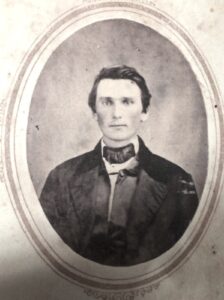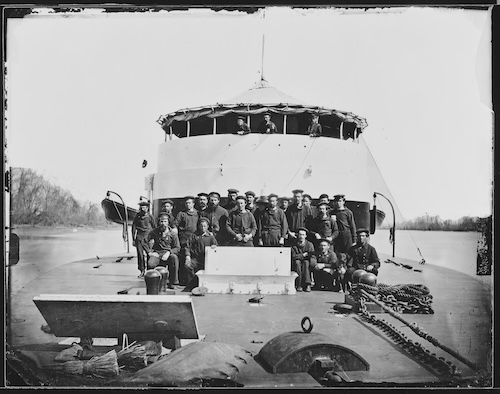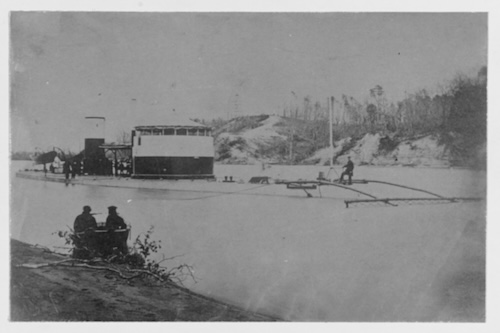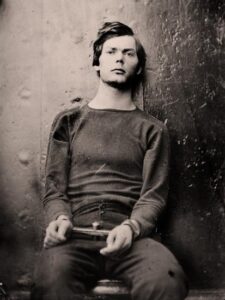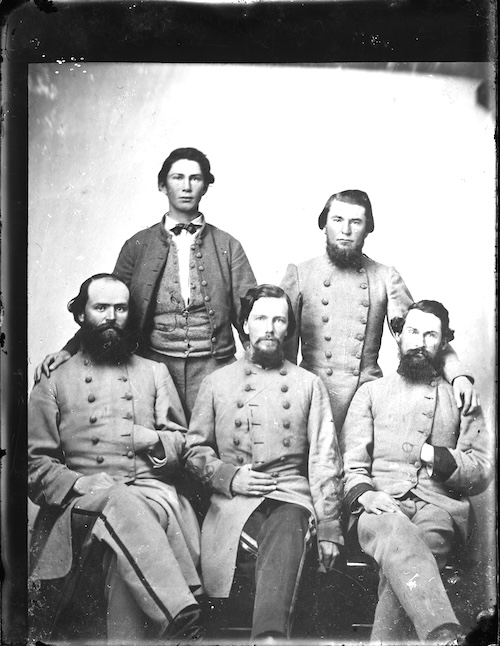Adam Swartzlander (c. 1853)
26 April 2025
Raised a farmer, Adam Swartlander left a wife and 3 small children at home in Butler County near Pittsburgh, PA when he enlisted in July 1861 as a Private in Company C of the 9th Pennsylvania Reserves. He was killed just over a year later at Antietam on 17 September 1862, not quite 30 years old.
Here he is in younger days. I’m guessing on the occasion of his marriage in March 1853.
Thanks to the photograph’s owner sstacy155853, who shared it to fold3, and to Jim Buchanan for finding it for us.
Crew on monitor “Saugus”, James River (c. 1865)
21 April 2025
I’ve occasionally found Confederate veterans of the Battle of Sharpsburg who were later captured but were released from prison by taking an oath and enlisting for United States Army service in US Volunteer Infantry regiments – soldiers known also as Galvanized Yankees. Apparently more than 5,000 ex-Confederates served in those units before the end of the war.
Yesterday I came upon a case of galvanizing unlike any of those I’d seen before:
Private David Bailey of Company C, 13th Alabama Infantry was captured at Sharpsburg in 1862 but soon after exchanged and returned to his unit. He was captured again, at Gettysburg in July 1863, and sent to Fort Delaware. The following spring he enlisted there as Landsman, US Navy – a Landsman being an entry-level sailor with no seagoing experience.
He was assigned to the armored monitor USS Saugus by July 1864 and probably served aboard as she operated on the James River near Richmond, VA into 1865. Here’s a lovely photograph of the crew on her foredeck, her massive gun turret behind them.
It is possible that Landsman Bailey is among those sailors. He was described at enlistment in the Navy as a 23 year old carpenter, 5′ 7″ tall, with dark complexion and hair and brown eyes, and a scar on his left arm. Perhaps you can pick him out.
Here’s another look at USS Saugus, with a minesweeping “rake” attached to her bow, on the James in early 1865.
I don’t know how long Bailey was aboard the ship; he was paroled as a Confederate soldier at Montgomery, Alabama in May 1865, and afterward disappeared from (my) view.
Notes
The photograph of the crew aboard USS Saugus is from the US National Archives. There’s another photograph, probably taken on the same day from the same location, of the officers of the ship – that photo is in the collection of the Naval Heritage and History Command (NHHC).
As is the side view of USS Saugus.
For much more about USS Saugus and her service, see the ship’s history page from the NHHC.
A paragraph in that history connects USS Saugus to another Sharpsburg veteran, Lewis Powell (aka Lewis Payne), photographed aboard the ship in front of the gun turret on 27 April 1865 by Alexander Gardner:
Saugus remained in the upper James until after the Confederate squadron was scuttled on the night of 2 and 3 April and Richmond had fallen. She then returned to the Washington Navy Yard. After the assassination of President Lincoln, eight of the suspected conspirators were incarcerated in monitors Saugus and Montuck below decks under heavy guard. The prisoners were manacled with wrist and leg irons and blindfolded. On the 30th, they were transferred to the Arsenal Penitentiary located on the ground now occupied by Fort McNair. Three were later to be hanged, three sentenced to prison terms, and two released without being brought to trial.
E.M. Law & friends (c. 1864)
7 April 2025
I came upon this photograph while looking into men of Colonel Evander McIver Law‘s brigade staff at Sharpsburg in September 1862: it’s in the collection of the Valentine Museum in Richmond, VA and originally titled Common Soldiers from Charles City, possibly a reference to where the photograph was taken in Charles City County, VA southeast of Richmond.
Perhaps obviously, that’s by-then Brigadier General Law in the front, center.
Thanks to Ron Coddington and others, I think we have the identities of the other men in the picture. Four of the five were at Sharpsburg.
First, standing at our left, is John Kolb Law, Evander’s younger brother. He was a Cadet in the Citadel when he joined his brother as a volunteer aide in the Summer of 1862. He was wounded in the ankle at Sharpsburg and, after graduation in 1863, was an Enrolling Officer to the end of the war.
Standing at the right is Mims Walker who was a Private in Company D, 4th Alabama – Colonel Law’s old unit – and was detailed as courier to Law at Gaines Mill in June 1862. He was on furlough in August and September 1862, so not at Sharpsburg, but returned afterward as a courier into 1864, when he was appointed Lieutenant and Aide-de-camp on the General’s staff.
Seated at the left is Leigh Richmond Terrell, 2nd Lieutenant of Company D, 4th Alabama Infantry, who was detailed to Colonel Law as Assistant Adjutant General in about August 1862 and was with him at Sharpsburg and afterward until 1864, when he was appointed Lieutenant Colonel of the 47th Alabama Infantry. He was mortally wounded at Petersburg in October 1864.
Sitting to our right is Surgeon Charles Thomas Taliaferro, of the 4th Alabama Infantry. He had enlisted as a Private and was 2nd Lieutenant of Company E of the 4th Alabama at Sharpsburg. He was appointed Assistant Surgeon of the regiment in February 1863 and Surgeon in February 1864. Although probably never on General Law’s staff, he certainly would have been well known to him.
Notes
Ron Coddington featured the photograph in his article The Little Gamecock: The Rise of Brig. Gen. Evander McIver Law, C.S.A. in the Summer 2024 issue of Military Images magazine, and shared that piece online.
The original glass-plate negative is at the Valentine Museum and they posted the print used here online.
